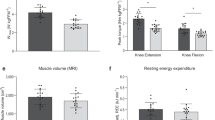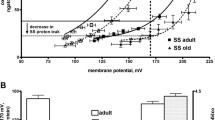Abstract
The mitochondrial theory of ageing was tested. Isolated mitochondria from the quadriceps muscle from normal, healthy, young (age 20+ years, n=12) and elderly (70+ years, n=11) humans were studied in respiratory experiments and the data expressed as activities of the muscle. In each group, the subjects exhibited a variation of physical activity but, on average, the groups were representative for their age with maximum O2 consumption rate of 50±9 and 34±13 ml min−1 kg−1 (mean±SD), respectively. Thirteen different activities were assayed. α-Glycerophosphate oxidation was lower in the 70+ group (38%, P~0.001), as was the respiratory capacity for fatty acids (19%, P~0.03). The remaining eleven activities, including those of the central bioenergetic reactions, were not lower in the 70+ group. Pyruvate and α-ketoglutarate dehydrogenase activities (i.e. the tricarboxylic acid cycle turnover) and the respiratory chain activity could all account for ~14 mmol O2 min−1 kg−1 muscle (37 °C). The capacity for aerobic ATP synthesis was ~35 mmol ATP min−1 kg−1. The mitochondrial capacities were far in excess of whole-body performance. They were related to physical activity, but not to age. The mitochondrial theory of ageing, which attributes the age-related decline of muscle performance to decreased mitochondrial function, is incompatible with these results.

Similar content being viewed by others
References
Ames BN, Shigenaga MK, Hagen TM (1995) Mitochondrial decay in aging. Biochim Biophys Acta 1271:165–170
Atamna H, Walter PB, Ames BN (2002) The role of heme and iron-sulfur clusters in mitochondrial biogenesis, maintenance, and decay with age. Arch Biochem Biophys 397:345–353
Barrientos A, Casademont J, Rötig A, Miró Ò, Urbano-Márquez A, Rustin P, Cardellach F (1996) Absence of relationship between the level of electron transport chain activities and aging in human skeletal muscle. Biochem Biophys Res Commun 229:536–539
Beckman KB, Ames BN (1998) The free radical theory of aging matures. Physiol Rev 78:547–581
Blei ML, Conley KE, Kushmerick MJ (1993) Separate measures of ATP utilization and recovery in human skeletal muscle. J Physiol (Lond) 465:203–222
Boffoli D, Scacco SC, Vergari R, Solarino G, Santacroce G, Papa S (1994) Decline with age of the respiratory chain activity in human skeletal muscle. Biochim Biophys Acta 1226:73–82
Boffoli D, Scacco SC, Vergari R, Persio MT, Solarino G, Laforgia R, Papa S (1996) Ageing associated in females with a decline in the content and activity of the b-c1 complex in skeletal muscle mitochondria. Biochim Biophys Acta 1315:66–72
Brierley EJ, Johnson MA, James OFW, Turnbull DM (1996) Effects of physical activity and age on mitochondrial function. Q J Med 89:251–258
Brierley EJ, Johnson MA, Bowman A, Ford GA, Subhan F, Reed JW, James OFW, Turnbull DM (1997) Mitochondrial function in muscle from elderly athletes. Ann Neurol 41:114–116
Brierley EJ, Johnson MA, Lightowlers RN, James OFW, Turnbull DM (1998) Role of mitochondrial DNA mutations in human aging: implications for the central nervous system and muscle. Ann Neurol 43:217–223
Brooke MH, Kaiser KK (1970) Three myosine adenosine triphosphatase systems: the nature of their pH lability and sulfhydryl dependence. J Histochem Cytochem 18:670–672
Brunk UT, Terman A (2002) The mitochondrial-lysosomal axis theory of aging. Accumulation of damaged mitochondria as a result of imperfect autophagocytosis. Eur J Biochem 269:1996–2002
Calabrese V, Scapagnini G, Giuffrida Stella AM, Bates TE, Clark JB (2001) Mitochondrial involvement in brain function and dysfunction: relevance to aging, neurodegerative disorders and longevity. Neurochem Res 26:739–764
Chretien D, Gallego J, Barrientos A, Casademont J, Cardellach F, Munnich A, Rötic A, Rustin P (1998) Biochemical parameters for the diagnosis of mitochondrial respiratory chain deficiency in humans, and their lack of age-related changes. Biochem J 329:249–254
Coggan AR, Spina RJ, Rogers MA, King DS, Brown M, Nemeth PM, Holloszy JO (1990) Histochemical and enzymatic characteristics of skeletal muscle in master athletes. J Appl Physiol 68:1896–1901
Coggan AR, Spina RJ, King DS, Rogers MA, Brown M, Nemeth PM, Holloszy JO (1992) Histochemical and enzymatic comparison of the gastrocnemius muscle of young and elderly men and women. J Gerontol 47:B71–B76
Coggan AR, Abduljalil AM, Swanson SC, Earle MS, Farris JW, Mendenhall LA, Robitaille P-M (1993) Muscle metabolism during exercise in young and older untrained and endurance-trained men J Appl Physiol 75:2125–2133
Cooper JM, Mann VM, Schapira AHV (1992) Analyses of respiratory chain function and mitochondrial DNA deletion in human skeletal muscle: effect of ageing. J Neurol Sci 113:91–98
Durnin JVGA, Womersley J (1974) Body fat assessed from total body density and its estimation from skinfold thickness: measurements on 481 men and women aged from 16 to 72 years. Br J Nutr 32:77–97
Hansford RG (1983) Bioenergetics in aging. Biochim Biophys Acta 726:41–80
Jackman MR, Willis WT (1996) Characteristics of mitochondria isolated from type I and type IIb skeletal muscle. Am J Physiol 270:C673–C678
Kent-Braun JA, NG AV (2000) Skeletal muscle oxidative capacity in young and older women and men. J Appl Physiol 89:1072–1078
Klitgaard H, Mantoni M, Schiaffino S, Ausoni S, Gorza L, Laurent-Winter C, Schnohr P, Saltin B (1990) Function, morphology and protein expression of ageing skeletal muscle: a cross-sectional study of elderly men with different training backgrounds. Acta Physiol Scand 140:41–54
Kovanen V, Suominen H, Risteli J, Risteli L (1988) Type IV collagen and laminin in slow and fast skeletal muscle in rats—effects of age and life-time endurance training. Coll Relat Res 8:145–153
Kowald A (2001) The mitochondrial theory of aging. Biol Signals Recept 10:162–175
Larsson L, Grimby G, Karlsson J (1979) Muscle strength and speed of movement in relation to age and muscle morphology. J Appl Physiol 46:451–456
Lexell J (1995) Human aging, muscle mass, and fiber type composition. J Gerontol 50:A11–A16
Lexell J, Taylor CC, Sjöström M (1988) What is the cause of the ageing atrophy? Total number, size and proportion of different fiber types studied in whole vastus lateralis muscle from 15- to 83-year-old men. J Neurol Sci 84:275–294
McCully KK, Fielding RA, Evans WJ, Leigh JS, Posner JD (1993) Relationships between in vivo and in vitro measurements of metabolism in young and old human calf muscles. J Appl Physiol 75:813–819
Meredith CN, Frontera WR, Fisher EC, Hughes VA, Herland JC, Edwards J, Ewans WJ (1989) Peripheral effects of endurance training in young and old subjects. J Appl Physiol 66:2844–2849
Miró Ò, Casademont J, Casals E, Perea M, Urbano-Márquez Á, Rustin P, Cardellach F (2000) Aging is associated with increased lipid peroxidation in human hearts, but not with mitochondrial respiratory chain defects. Cardiovasc Res 47:624–631
Örlander J, Aniansson A (1980) Effects of physical training on skeletal muscle metabolism and ultrastructure in 70 to 75-year-old men. Acta Physiol Scand 109:149–154
Ozawa T (1997) Genetic and functional changes in mitochondria associated with aging. Physiol Rev 77:425–464
Papa S (1996) Mitochondrial oxidative phosphorylation changes in the life span. Molecular aspects and physiopathological implications. Biochim Biophys Acta 1276:87–105
Pesce V, Cormio A, Fracasso F, Vecchiet J, Felzani G, Lezza AMS, Cantatore P, Gadaleta MN (2001) Age-related mitochondrial genotypic and phenotypic alterations in human skeletal muscle. Free Radic Biol Med 30:1223–1233
Proctor DN, Joyner MJ (1997) Skeletal muscle mass and the reduction of V̇O2,max in trained older subjects. J Appl Physiol 82:1411–1415
Proctor DN, Sinning WE, Walro JM, Sieck GC, Lemon PWR (1995) Oxidative capacity of human muscle fiber types: effects of age and training status. J Appl Physiol 78:2033–2038
Rasmussen HN, Rasmussen UF (1993) Respiration measurements in small scale. Anal Biochem 208:244–248
Rasmussen UF, Rasmussen HN (2000) Human quadriceps muscle mitochondria: a functional characterization. Mol Cell Biochem 208: 37–44
Rasmussen UF, Rasmussen HN (2000) Human skeletal muscle mitochondrial capacity. Acta Physiol Scand 168:473–480
Rasmussen HN, Andersen AJ, Rasmussen UF (1997) Optimization of preparation of mitochondria from 25–100 mg skeletal muscle. Anal Biochem 252:153–159
Rasmussen UF, Krustrup P, Bangsbo J, Rasmussen HN (2001) The effect of high-intensity exhaustive exercise studied in isolated mitochondria from human skeletal muscle. Pflugers Arch 443:180–187
Rasmussen UF, Rasmussen HN, Krustrup P, Quistorff B, Saltin B, Bangsbo J (2001) Aerobic metabolism of human quadriceps muscle: in vivo data parallel measurements on isolated mitochondria. Am J Physiol 280:E301–E307
Rifai Z, Welle S, Kamp C, Thornton CA (1995) Ragged red fibers in normal aging and inflammatory myopathy. Ann Neurol 37:24–29
Shepherd D, Garland PG (1969) Citrate synthase from rat liver. Methods Enzymol 13:11–16
Sial S, Coggan AR, Carroll R, Goodwin J, Klein S (1996) Fat and carbohydrate metabolism during exercise in elderly and young subjects. Am J Physiol 271:E983–E989
Taylor DJ, Crowe M, Bore PJ, Styles P, Arnold DL, Radda GK (1984) Examination of the energetics of aging skeletal muscle using nuclear magnetic resonance. Gerontology 30:2–7
Trounce I, Byrne E, Marzuki S (1989) Decline in skeletal muscle mitochondrial respiratory chain function: possible factor in ageing. Lancet 25:637–639
Van Remmen H, Richardson A (2001) Oxidative damage to mitochondria and aging. Exp Gerontol 36:957–968
Wallace DC (1999) Mitochondrial diseases in man and mouse. Science 283:1482–1488
Wei Y-H, Lu C-Y, Wei C-Y, Ma Y-S, Lee H-C (2001) Oxidative stress in human aging and mitochondrial disease—consequences of defective mitochondrial respiration and impaired antioxidant enzyme system. Chin J Physiol 44:1–11
Wilson PD, Franks LM (1975) The effect of age on mitochondrial ultrastructure and enzymes. Adv Exp Med Biol 53:171–183
Acknowledgements
We wish to express our gratitude to all of the enthusiastic volunteers, without whom this study would not have been possible. It was a most positive experience to collaborate with both the 20+ and 70+ age groups. The expert technical assistance of Ms. I-L. Føhns, H. Lauritzen, I. Kring and Mr. B. Larson is gratefully acknowledged. The study was supported by grant 504-14 from The Danish Research Foundation.
Author information
Authors and Affiliations
Corresponding author
Rights and permissions
About this article
Cite this article
Rasmussen, U.F., Krustrup, P., Kjaer, M. et al. Human skeletal muscle mitochondrial metabolism in youth and senescence: no signs of functional changes in ATP formation and mitochondrial oxidative capacity. Pflugers Arch - Eur J Physiol 446, 270–278 (2003). https://doi.org/10.1007/s00424-003-1022-2
Received:
Accepted:
Published:
Issue Date:
DOI: https://doi.org/10.1007/s00424-003-1022-2




